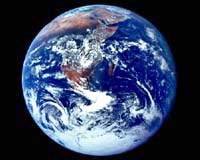
 |
Until last December, the only night-time light in Sidi Sebaa, 120 kilometers (75 miles) by pot-holed road from Casablanca, came from candles or paraffin lamps. Televisions were powered by small petrol generators or from cables hooked up to truck batteries.
Today, the clatter, pollution and cost of those energy sources have disappeared.
Set up on home balconies to harvest sunlight, 12-volt solar panels provide households with 50 watts: enough to power between four and eight lightbulbs as well as the TV, invariably enthroned in pride of place in the main room.
"As far as I am concerned, solar power is a step forward," says Wafa Ouardi, a young woman who is the village's primary-school teacher.
Life in Sidi Sebaa "is very difficult," she says. With the magic of electricity, she can correct the pupils' schoolwork at night, watch television or even a film on her DVD player.
Others, though, complain that the panels are too puny to provide more than just an elusive taste of an easier life.
"People here are asking why they were not connected to the national electricity grid," says an elder. "Solar power is only enough for a few lightbulbs and the TV, but not the fridge."
The panel initiative is the result of a tie-up between France's state-run electricity producer, EDF, the French oil and gas giant Total and a solar power specialist they jointly own, Temasol.
"The electricity grid provides an economic structure," says Mohammed Berdai, director of a Moroccan agency, the Centre for the Development of Renewable Energies (CDER).
"It not only brings electricity but also roads, shops, other activities."
"Solar power is clearly considered here to be the poor man's energy source," admits Henri Boye, EDF's chief representative in Morocco.
"But when it comes to remote villages, you can't cable up everywhere, it would cost too much. The choice is not whether you get hooked up to the grid or solar power, it is between solar power and nothing."
Forty-four percent of Morocco's 30 million people live in rural areas.
Since 1994, the number of countryside dwellers with electricity has risen from 17 percent to just over than 50 percent, virtually all of them connected to the grid.
The goal is 100 percent by 2007, and solar power is a major part of the mix, along with wind turbines, mini-networks powered by petrol generators or, of course, mains electricity.
Whenever it costs more than 27,000 dirhams (2,700 euros, 3,200 dollars) to connect a household up to the grid, engineers turn to solar.
The panels are not a gift. They must be rented by the household. The price is heavily subsidised thanks to international support but at 65 dirhamseuros, 7.8 dollars) a month is still high enough to ensure that the household looks after the equipment. Consumers who are already connected to the grid pay a small tax -- two percent of their monthly bill -- to help fellow Moroccans get access to solar.
To win over doubters, Temasol undertakes to maintain the panels for 10 years after purchase.
Temasol has already provided solar power for 6,000 rural homes, and is bidding for more work under a programme tranche to supply 110,000 households.
"We want to prove that solar is cost effective," Temasol's director, Stephane Maureau.
The company is planning to offer a "fridge" option for households -- if they pay more, they will get a bigger panel to generate more power which will enable them to run a refrigerator.
But, says Maureau, around 20 percent of customers are too poor ever to envisage this.
* A four-day international conference on alternative energies to fossil fuels opens in Bonn on Tuesday.
TERRA.WIRE |